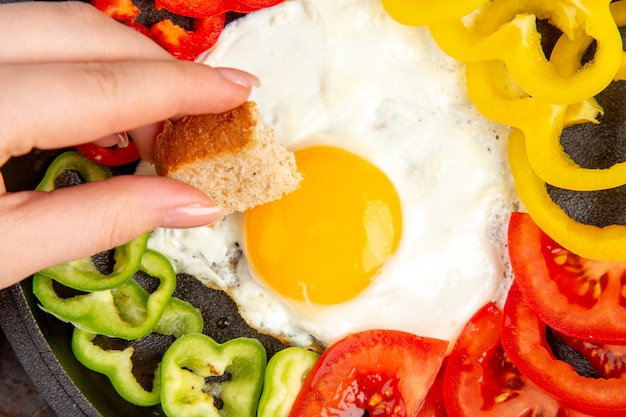Let's talk eggs, folks. We all know they're a breakfast staple, a lunch-time treat, and a dinner hero. The best part? They're incredibly versatile. You can cook them up in a million different ways, from sunny-side-up to boiled to poached, and don't even get me started on all the egg-based dishes out there. But honestly, there's one method I find myself turning to more and more these days, and that's cooking eggs in the microwave. Yes, you heard that right – the microwave!
This guide is your one-stop shop for exploring the wonderful world of microwave egg cooking. I'll share my tried-and-tested techniques for perfecting scrambled eggs, poached eggs, and even omelettes in the microwave. We'll delve into the best equipment, the essential tips and tricks, and the things you definitely want to avoid. Get ready to level up your egg game, because we're about to dive into the ultimate microwave egg cooking experience!
(Part 1) The Microwave Egg Revelation

I'll admit, I was skeptical at first. Microwaves and eggs – it seemed like a recipe for disaster. But then, I discovered the magic of microwave egg cooking, and I haven't looked back.
The 'Aha' Moment
My 'aha' moment came on a morning when I was seriously late. My usual breakfast routine was a quick scramble, but I was running behind. I remembered seeing something about microwaving eggs online, so I thought, "What the heck, let's try it." I grabbed a mug, cracked in an egg, added a splash of milk, and zapped it for a minute. And you know what? It was perfect! Perfectly cooked, fluffy scrambled eggs, ready in under a minute.
The Benefits of Microwave Egg Cooking
Honestly, I've been hooked ever since. Here's why I think microwave egg cooking is a total game-changer:
- Speed: It's so much faster than traditional methods. You can have perfectly cooked eggs in a matter of minutes, even seconds for some recipes. Imagine having breakfast ready before the kettle even boils!
- Convenience: It's super easy to clean up. No need for greasy pans or messy spills. Just a quick rinse of your mug or bowl, and you're done. Perfect for those mornings when you're short on time and energy.
- Versatility: You can cook just about any type of egg in the microwave, from scrambled and poached to omelettes and even fried eggs (yes, really!). It's amazing how versatile this method is. No more being limited by your stovetop or oven.
- No oil or butter needed: You can enjoy a healthier version of your favorite egg dishes, with fewer calories and fat. This is a big plus for those who are watching their waistline or simply prefer a lighter meal.
(Part 2) Essential Equipment for Microwave Egg Cooking

Now, you don't need a fancy, high-tech microwave to cook eggs. Any standard microwave will do the trick. However, there are a few pieces of equipment that I highly recommend for optimal results:
1. Microwave-Safe Dishes
The first thing you'll need is a microwave-safe dish. I personally prefer using mugs, as they're the perfect size for one or two eggs. But you can also use bowls, ramekins, or even special egg-cooking containers. Just make sure the dish is specifically labelled as microwave-safe. You don't want any surprises when your dish starts to melt!
2. A Fork
A fork is your best friend when it comes to scrambling eggs. You'll need it to whisk the eggs, mix in any additional ingredients, and check for doneness.
3. A Timer
A kitchen timer is crucial for getting those eggs just right. You don't want them overcooked, so keep a close eye on the time. I've been known to get distracted by emails or phone calls, so a timer is a lifesaver.
4. A silicone spatula
A silicone spatula is great for scraping those perfectly cooked eggs out of your mug or dish. It's also handy for stirring and mixing your eggs while they're cooking.
5. A Microwave-Safe Lid (Optional)
A microwave-safe lid is optional but can be really useful for preventing splatters and cooking your eggs more evenly. I especially recommend a lid for poached eggs, as it helps create a more traditional poached egg experience.
(Part 3) The Basic Microwave Egg Cooking Technique

Okay, let's get down to the nitty-gritty. Here's a basic technique you can use for all sorts of egg dishes:
1. Prep Your Eggs
Crack your eggs into your chosen microwave-safe dish. You want to make sure you get all the egg whites and yolks in the dish without any shells!
2. Add Any Extras
Now's the time to add any extras you fancy, like milk, cream, cheese, herbs, or spices. Just remember that the more liquid you add, the longer your cooking time will be. I like to add a splash of milk to my scrambled eggs for a bit of extra creaminess, but you can get creative with your additions.
3. Whisk It Up
Use your fork to whisk the eggs thoroughly. You want them to be nicely mixed and smooth. This will help them cook evenly and prevent any rubbery bits.
4. Microwave and Monitor
Cover your dish with a microwave-safe lid (optional) and microwave for 30-60 seconds, depending on the power of your microwave. Check on your eggs regularly. I usually start with a 30-second burst and then check for doneness. If they're not quite set, I microwave for another 10-15 seconds at a time.
5. Check for Doneness
Use a fork to check the doneness of your eggs. If they're still runny, microwave for another 10-15 seconds, checking again every few seconds. You want the eggs to be cooked through but still moist and tender. Don't overcook them, or they'll become rubbery.
6. Season to Taste
Season your cooked eggs with salt and pepper to your liking. I often add a pinch of salt and pepper directly to the eggs before microwaving, but you can also season them after cooking.
(Part 4) Mastering the microwave scrambled eggs
Scrambled eggs are a classic breakfast staple, and they're a breeze to make in the microwave. Here's how to achieve perfect, fluffy scrambled eggs in a flash:
1. Crack and Whisk
Crack your eggs into a microwave-safe mug or bowl. Whisk them thoroughly with a fork, ensuring all the yolks and whites are well combined. You want to create a smooth, uniform mixture for even cooking.
2. Add Liquid
For super-fluffy scrambled eggs, add a tablespoon of milk or cream to your whisked eggs. This will help to create a lighter texture and prevent the eggs from becoming dry.
3. Microwave in Bursts
Microwave your egg mixture for 30-45 seconds. Check for doneness, and if they're still runny, microwave for another 10-15 seconds at a time. Don't overcook them, or they'll become dry and rubbery.
4. Stir and Enjoy
Use a fork to stir the scrambled eggs thoroughly. You want them to be smooth and creamy. Season with salt and pepper, and enjoy your perfect microwave scrambled eggs!
(Part 5) The Art of microwave poached eggs
Poached eggs are a bit more of a challenge, but trust me, they're totally achievable in the microwave. Here's my foolproof method:
1. The Right Dish
For microwave poached eggs, you'll need a shallow, wide dish. A pie plate or a large, flat bowl works well. You want the egg to have enough space to cook evenly.
2. Add Water
Fill your dish with about 1/2 inch of water. The water should be enough to cover the bottom of the dish but not too deep that it will overflow during cooking.
3. Crack and Swirl
Carefully crack an egg into a small bowl. Gently swirl the water in your dish to create a whirlpool effect. Then, slowly pour the egg into the center of the swirling water. The swirling water will help the egg form a nice, round shape.
4. Microwave and Watch
Cover your dish with a microwave-safe lid or plastic wrap (make sure to poke a few holes in the plastic wrap to allow steam to escape). Microwave for 45-60 seconds, checking for doneness every 15-20 seconds. The cooking time will vary depending on the power of your microwave.
5. The doneness test
Use a spoon to lift the egg gently. The white should be set and the yolk should be runny. If it's not quite cooked yet, microwave for another 10-15 seconds. You want the white to be cooked through but the yolk to remain soft and runny.
6. Serve and Enjoy
Carefully remove the poached egg from the water using a slotted spoon. Serve it on toast, a salad, or whatever you fancy. Enjoy!
(Part 6) The Ultimate Guide to microwave omelettes
Omelettes are a bit more complex, but with the right approach, you can whip up a tasty omelette in your microwave in no time.
1. Prep Your Ingredients
Choose your favorite omelette fillings, like cheese, vegetables, ham, or mushrooms. Chop them into small pieces so they cook evenly. You can get creative with your fillings and create your own unique omelettes.
2. The Egg Mixture
Crack two or three eggs into a microwave-safe mug or bowl and whisk them together. You want the eggs to be well combined for a smooth and even omelette.
3. Microwave in Stages
Microwave your egg mixture for 30-45 seconds, checking for doneness every 15-20 seconds. You want the eggs to be almost set but still slightly runny.
4. Add the Fillings
Once the eggs are almost set, remove the mug from the microwave and add your chosen fillings. Gently stir the fillings into the eggs.
5. Microwave Again
Return the mug to the microwave and cook for another 15-20 seconds. This will allow the fillings to cook and the omelette to set properly.
6. Folding and Serving
Use a fork to fold the omelette in half or into thirds. Remove it from the mug and enjoy your microwave omelette!
(Part 7) Tips and Tricks for Perfect microwave eggs
Here are a few insider tips and tricks to help you become a microwave egg master:
- Use fresh eggs: Fresh eggs will cook more evenly and produce better results. You can test the freshness of your eggs by placing them in a bowl of cold water. If they sink to the bottom and lay flat, they're fresh. If they float, they're older and might not cook as well.
- Don't Overcook: Microwave eggs can cook quickly, so watch them carefully and avoid overcooking. Overcooked eggs will be rubbery and dry. It's better to err on the side of undercooked than overcooked, as you can always microwave them for a few more seconds if needed.
- Add Liquid for Fluffy Scrambled Eggs: Milk or cream will create a lighter and fluffier texture in your scrambled eggs. They also help to prevent the eggs from becoming dry.
- Use a Lid to Prevent Splatters: A microwave-safe lid will help to contain the splatters and cook your eggs more evenly. It also helps to trap the steam, which helps the eggs cook more evenly.
- Season with Care: Season your eggs after cooking, as over-seasoning can lead to a salty flavor. You can always add more salt and pepper to taste after the eggs are cooked.
(Part 8) Avoiding Common Microwave Egg Mistakes
Everyone makes mistakes, but with a little know-how, you can avoid common microwave egg pitfalls. Here are a few things to keep in mind:
- Don't Use Metal Utensils: Never use metal utensils in the microwave. They can spark and create a fire hazard. Always use microwave-safe utensils, such as plastic or silicone.
- Be Careful with Plastic Wrap: If you use plastic wrap to cover your eggs, make sure to poke a few holes in it to allow steam to escape. Overheated plastic wrap can melt or release harmful chemicals. A microwave-safe lid is a much safer option.
- Don't Overcrowed the Microwave: Make sure to give your eggs enough space in the microwave. Overcrowding can lead to uneven cooking and splatters. If you're cooking multiple eggs, try using separate dishes or adjusting the cooking time accordingly.
(Part 9) Microwave Egg Variations and Experimentation
Once you've mastered the basic techniques, you can start to experiment with different variations and flavors. Here are a few ideas to get you started:
1. Spicy Scrambled Eggs
Add a pinch of cayenne pepper or hot sauce to your scrambled eggs for a spicy kick. You can adjust the amount of spice to your liking.
2. Cheesy Scrambled Eggs
Stir in some grated cheese to your scrambled eggs for a cheesy treat. Try cheddar, mozzarella, or even a mix of cheeses. You can also add a sprinkle of cheese to your eggs before microwaving for a melty, cheesy finish.
3. Herby Omelette
Incorporate chopped fresh herbs like parsley, chives, or basil into your omelette. These herbs will add a fresh, fragrant flavor to your omelette.
4. Vegetable Omelette
Add chopped vegetables to your omelette for a healthy and flavorful meal. Try mushrooms, onions, peppers, spinach, or tomatoes. You can also add a mix of vegetables for a more colorful and nutritious omelette.
5. Mushroom and Cheese Omelette
This is a classic combination. Add sautéed mushrooms and grated cheese to your omelette for a delicious and satisfying dish.
6. Ham and Cheese Omelette
This is a popular choice for breakfast. Add chopped ham and cheese to your omelette for a savory and satisfying meal. You can also add other ingredients, like onions or peppers, to create your own unique version.
(Part 10) Microwave Egg Cooking vs. Traditional Methods
I love the convenience and speed of microwave egg cooking, but it's always good to compare it to traditional methods. Here's a breakdown:
| Microwave Egg Cooking | Traditional Egg Cooking | |
|---|---|---|
| Speed | Super fast, 1-2 minutes for scrambled eggs | Takes longer, especially for poached eggs |
| Convenience | Easy cleanup, no messy pans | Can be messy, requires washing dishes |
| Versatility | Can cook various types of eggs, including scrambled, poached, and omelettes | Requires different techniques for different types of eggs |
| Healthiness | Doesn't require oil or butter, lower fat | Often requires oil or butter, can be higher in fat |
(Part 11) FAQs
1. What if my eggs are too runny?
If your eggs are still runny after microwaving, simply microwave them for another 10-15 seconds, checking for doneness every few seconds.
2. Can I microwave eggs in the shell?
No, never microwave eggs in the shell. They will explode, creating a messy and potentially dangerous situation. Always crack the eggs before microwaving.
3. How do I know if my eggs are fresh?
To check the freshness of your eggs, place them in a bowl of cold water. If they sink to the bottom and lay flat, they're fresh. If they float, they're older and might not cook as well.
4. What if my microwave doesn't have a timer?
If your microwave doesn't have a timer, use a kitchen timer to keep track of your cooking time.
5. Can I cook multiple eggs at once in the microwave?
Yes, you can cook multiple eggs at once, but you'll need to adjust the cooking time. Start with 30-45 seconds for two eggs, and increase the time accordingly for more eggs. You may also need to use larger dishes to accommodate all the eggs.
(Part 12) The Final Word: Embracing Microwave Egg Cooking
So there you have it – my ultimate guide to microwave egg cooking! It's a quick, convenient, and incredibly versatile method that I reckon you'll love. Give it a try, and you'll see for yourself just how amazing microwave eggs can be. Enjoy those perfect poached eggs, fluffy scrambled eggs, and delicious omelettes, all made in the blink of an eye. Happy egg cooking!
Everyone is watching

How to Cook Frozen Lobster Tails Perfectly: A Step-by-Step Guide
RecipesLobster. Just the word conjures up images of lavish meals, special occasions, and a taste of luxury. But let's...

Pigs in a Blanket Cooking Time: How Long to Bake for Perfect Results
RecipesAh, pigs in a blanket. Just the name conjures up images of those delightful little parcels of crispy pastry en...

Pork Fillet Cooking Time: How Long to Cook It Perfectly
RecipesPork fillet, or tenderloin as it's sometimes called, is a real favourite in our house. It's so versatile, and...

The Ultimate Guide to Cooking Delicious Frankfurters
RecipesLet's face it, we all love a good frankfurter. It's a classic, simple, and always satisfying. But let's be rea...

Wolf Meat Recipes: A Guide to Cooking Wild Game
RecipesLet's be honest, you don't see wolf meat at your local butcher shop every day. It's a bit of a wild card, but ...
